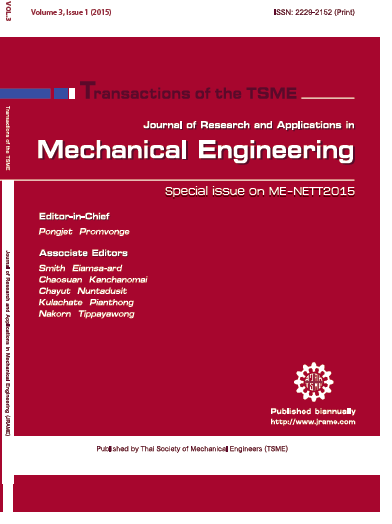Influence of shock absorber installation angle to automotive vehicle response
Main Article Content
Abstract
The installation angle of shock absorber is found theoretically to affect the damping force. In this paper, the influence of installation angle was studied numerically and experimentally. Three installation angles of 0, 45 and 90 degrees with respect to the direction of motion were considered. The base excited single degree of freedom was set up for experimental study. A single cycle sine squared base excitation was implemented to simulate the road hump. The results show that the installation angle of 0 degrees is capable to stop sprung mass vibration in the shortest time compared to other installation angles. In contrast, the installation angle of 90 degrees results in the greater mass oscillation amplitude which degrades handling quality. The installation angle of shock absorber is found to influence directly the vibration characteristic of the vehicle. The shock absorber installation angle is then another aspect for the suspension design consideration.
Article Details
This work is licensed under a Creative Commons Attribution-NonCommercial-ShareAlike 4.0 International License.
References
[2] Surace, C., Worden, K. and Tomlinson, G. R. On the non-linear characteristics of automotive shock absorbers, Proceedings of the Institution of Mechanical Engineers, Part D: Journal of Automobile Engineering, Vol. 206(1), 1992, pp. 3-16.
[3] Calvo, J. A., López-Boada, B., Román, J. L. S. and Gauchía, A. Influence of a shock absorber model on vehicle dynamic simulation, Part D: Journal of Automobile Engineering, Vol. 223(2), 2009, pp. 189-203.
[4] Rajalingham, C. and Rakheja, S. Influence of suspension damper asymmetry on vehicle vibration response to ground excitation, Journal of Sound and Vibration, Vol. 266(5), 2003, pp. 1117-1129.
[5] Duym, S., Stiens, R. and Reybrouck, K. Evaluation of shock absorber models, Vehicle System Dynamics, Vol. 27(2), 1997, pp. 109-127.
[6] Cafferty, S. and Tomlinson, G. R. Characterization of automotive dampers using higher order frequency response functions, Proceedings of the Institution of Mechanical Engineers, Part D: Journal of Automobile Engineering, Vol. 211(3), 1997, pp. 181-203.
[7] Rao, M. D., Gruenberg, S. and Torab, H. Measurement of Dynamic Properties of Automotive Shock Absorbers for NVH, In Proceedings of the 1999 Noise and Vibration Conference, SAE Technical Paper 1999-01-1840.
[8] Worden, K., Hickey, D., Haroon, M. and Adams, D. E. Nonlinear system identification of automotive dampers: A time and frequency-domain analysis, Mechanical Systems and Signal Processing, Vol. 23(1), 2009, pp. 104-126.
[9] Waters, T. P., Hyun, Y. and Brennan, M. J. The effect of dual-rate suspension damping on vehicle response to transient road inputs, Journal of Vibration and Acoustics, Vol. 131(1), 2009, pp. 011004-011004.
[10] Tang, B. and Brennan, M. J. A comparison of two nonlinear damping mechanisms in a vibration isolator, Journal of Sound and Vibration, Vol. 332(3), 2013, pp. 510-520.
[11] Tang, B. and Brennan, M. J. A Comparison of the Effects of Nonlinear Damping on the Free Vibration of a Single-Degree-of-Freedom System, Journal of Vibration and Acoustics, Vol. 134(2) 2012, p. 024501.
[12] Traffic Calming, Local Transport Note 1/07, Department for Transport, 2007, London, UK.



